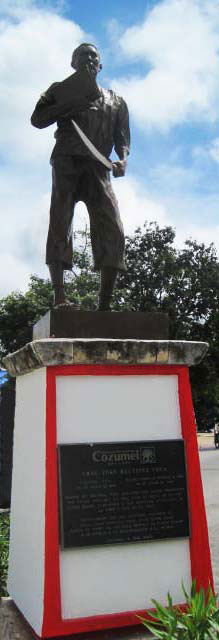 The statue of the man with a machete that stands at the intersection of Avenida Juarez and Calle Avenida 120 is Juan Bautista Vega.
The statue of the man with a machete that stands at the intersection of Avenida Juarez and Calle Avenida 120 is Juan Bautista Vega.
In the summer of 1897, a man reported to be a treasure hunter by the name of Dr. Juan Fábregas arrived on Cozumel with the intention of hiring a boat and crew to take him to Tulum. His request fell on deaf ears, however, as the War of the Casts was still in full swing and no one on Cozumel wanted to risk their lives entering the mainland stronghold of the Cruzoob Mayan rebels, or Bravos as they were called locally. The Cruzoob (Mayan plural of the Spanish word cruz, or “cross”) were a militant Mayan religious faction who worshiped la cruz parlante, or “the talking cross.” This cross was purported to pass the divine wishes of the creator down to the common folk as interpreted by a priest who listened to it, very similar to the “talking idols” of Ixchel in Cozumel. One of the directives passed down to the masewaloob, or Maya common folk, was that all Spaniards and half-breeds should be expunged from the land of Yucatan. To this end, beginning in 1847, the Cruzoob took it upon themselves to massacre Spaniards where and when the found them.
But money talks (in this case 13 pesos), and regardless of the danger, Fábregas eventually convinced Ruperto Loria to take him to Tulum. Loria picked out a mate, 22-year-old Ignacio Novela, to help with the sailboat’s rigging and at the last minute decided to take his 11-year-old stepson, Juan Bautista Vega, along for the ride. The trip across the channel was uneventful and the boat made landfall at Tulum beach safely. As the little group settled down for a quick lunch on the beach, they were approached by a group of Mayan rebels from the pueblo of Tulum. One thing lead to another and soon Loria, Fábregas, and Novela were all killed. Young Juan Bautista Vega was hauled off to the village of Tulum and tied to a tree. There he remained for several days, unable to communicate with his captors, as he spoke no Mayan and they no Spanish. Eventually, the boy was marched through Muyil and Chunpom to Yokdzonot, where the Cruzoob Gobernador, Felipe Yama, ordered him to be executed. A Black Belizean living with the rebels (known variously as Joe, José, Mr. Dyo, or Mr. Dio) pleaded for the boy’s life, saying that the kid could be useful since he was able to read and write. Yama relented and Vega was allowed to live.
Vega stayed with Joe for the next several months while he learned Mayan, but was later turned over to the Cruzoob high priest of Chunpóm, Florentino Cituk, where he became the priest’s secretary. The boy proved his worth, translating messages between the Cruzoob and the Yucatecan Army. He later married into Cituk’s family and became thoroughly Mayan, very similar to what happened to Gonzalo Guerrero almost 400 years earlier.
The Cruzoob rebels continued to fight engagements with the Yucatecan Army until a peace was negotiated in 1901. The treaty allowed the Mayans to choose their own local government, but even so, many holdouts refused to honor the terms of the peace agreement and sporadic fighting continued to occur for nearly 20 more years. In 1915, after the death of Cituk, Vega was named High priest of the Cruzoob and became their maximum leader, bearing the rank of General in the Cruzoob military. In 1918, the final peace agreement was finally worked out and the war of the Casts was over. Although he visited Cozumel in 1926, he never returned to live on the island. Vega died on July 28, 1969, still the highest ranking Cruzoob official.
Copyright 2011, Ric Hajovsky
